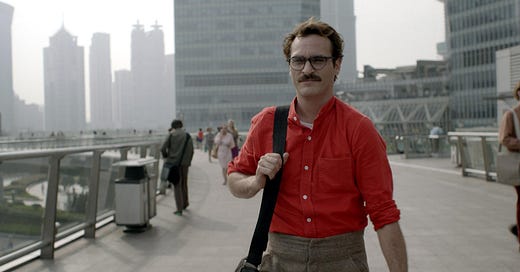Remember the movie "Her"? Theodore, the lonely writer at the heart of the story, finds solace in a relationship with Samantha, an AI. It’s a poignant, almost prophetic tale about how isolation and disconnection drive us to seek comfort through technology. But Theodore’s world doesn’t feel far-fetched anymore—it feels all too familiar. Swap Samantha for a Zoom meeting or dating app, and you’ve got today’s reality: a generation grappling with connection in a world where physical interactions are increasingly rare.
The pandemic fundamentally changed how we live, work, and interact. Remote work became the norm, offering freedom and flexibility, but it also ushered in an unintended side effect—an epidemic of isolation. Now, as companies push for return-to-office (RTO) policies, resistance is strong. Many have grown comfortable in their solo routines, finding the prospect of returning to the office unnecessary or even overwhelming.
But behind that resistance lies a deeper question: What are we sacrificing by staying isolated? What are we actually hiding from? We feel safe at home, cocooned in comfort, but to fill the void of loneliness, we turn to social media, shopping, porn, alcohol, gaming, and overworking ourselves. These are quick fixes for connection—not real solutions.
Important Note: There’s nothing wrong with being single. It’s the isolation part that harms us most as human beings.
The RTO Paradox: Freedom vs. Connection
One area we don’t explore enough is how remote work has reshaped connection. While it has revolutionized the workplace, it’s also upended the way we interact with the world—for better AND for worse. For singles, the workplace was often a reliable hub for socializing, networking, and even dating. Without watercooler chats, spontaneous lunch invites, or post-work happy hours, those organic opportunities have largely evaporated.
And while many celebrate remote work for offering focus and flexibility, it has quietly reshaped our social skills. Think about it: When’s the last time you initiated small talk outside your home? Or felt comfortable walking into a room of strangers? Returning to the office might feel inconvenient, but it also offers a chance to rebuild those human connections we don’t realize we’re missing.
Resistance to RTO isn’t just about stubbornness—it’s about comfort zones. A study found that loneliness and isolation are the most reported concerns among remote workers, with the lack of social interaction cited as a key drawback. The longer we stay isolated, the harder it becomes to navigate the real world and get what we want from it. Re-learning social cues, rebuilding confidence, and mastering face-to-face interactions might feel like a mountain to climb—but it’s not.
Isolation’s Hidden Impact
We don’t fully understand the long-term consequences of this shift toward isolation. But for singles, the impact runs deeper, touching emotional health, social skills, and even brain function. The brain craves interaction; without it, certain neural pathways tied to connection start to weaken. Here’s what that looks like:
Diminished Social Confidence: The less we interact, the less comfortable we become in social settings. Starting conversations, reading body language, and even maintaining eye contact start to feel unnatural. Over time, we convince ourselves we don’t need interaction at all.
Emotional Dysregulation: Social bonds buffer stress, help process emotions, and offer perspective. Without them, people are more prone to rumination and rejection sensitivity. About 1 in 3 adults in the U.S. report feeling lonely, and loneliness has been found to be as harmful to health as smoking 15 cigarettes a day. It’s easier to fall into unhealthy coping mechanisms like doomscrolling, gaming, or porn addiction.
The Dating Dilemma: Dating apps promise convenience but can’t replicate face-to-face chemistry. For singles—particularly men, who often rely on external validation for confidence—prolonged isolation fuels withdrawal and self-doubt.
Outsourcing Life to Apps: Many singles criticize dating apps for gamifying connection, yet we’ve outsourced everything else too—laundry, groceries, rideshares, even wellness. These tasks once rooted us in community, but now they’re solitary transactions.
How Isolation Affects Men and Women
Men
Men are culturally conditioned to suppress emotions and tie self-worth to achievements. Isolation amplifies these pressures, eroding confidence and making reintegration feel overwhelming. Many turn to toxic online content as a coping mechanism, which deepens feelings of disconnect and frustration. Men’s smaller social networks also leave them particularly vulnerable; globally, 1 in 5 men say they lack close friends to confide in.
Women
For women, isolation often intersects with social hierarchies and availability in their networks. It can amplify insecurities—whether about appearance, career identity, or the belief that suitable partners are scarce—reinforcing a pattern of self-imposed withdrawal. Women are also more likely to bear caregiving roles, making isolation emotionally and physically draining without an outlet.
It’s important to clarify: Being single isn’t the issue. The harm comes from prolonged disconnection, which deprives all humans of the support systems we fundamentally need.
Steps to Reconnect
Breaking free from isolation starts with small, intentional actions. Treat it like any other vice: manage it proactively instead of letting it change the course of your life.
Volunteer: Helping others fosters purpose and authentic connections.
Change Your Workspace: Work from a coffee shop or coworking space once a week to surround yourself with people.
Reconnect with Friends: Text someone you haven’t spoken to in months and plan to meet up.
Join Local Groups: From book clubs to sports leagues, find a community that shares your interests.
Take a Daily Walk and Compliment 3 People: Whether it’s “Nice shoes!” or “That color looks great on you!” small gestures open the door to engagement.
Start Small: Micro-interactions—like chatting with a barista—are the building blocks of social confidence.
Conclusion
The movie "Her" ends with Theodore stepping out into the world, rediscovering the richness of human connection after his virtual bond with Samantha fades. It’s a poignant reminder: while technology can fill gaps and make our lives more convenient, it can’t replace the desire for human connection.
We’re living through an era of unprecedented isolation, and its implications are still unfolding. But one thing is clear: connection matters. Whether it’s through returning to the office, joining a community, or simply saying yes to a coffee invite, the antidote to isolation is within reach. It’s time to make an intentional change—and take that first step.
Thank you for reading Syngle Economycs! Share this article with your homebody friends!!
References:
Remote Work and Isolation:
A study found that loneliness and isolation are the most reported concerns among remote workers, with many citing a lack of social interaction as a key drawback.
By 2025, an estimated 22% of the U.S. workforce will work remotely, reflecting a significant shift in how we interact professionally.
Mental Health and Social Isolation:
Social isolation has been linked to a 29% increased risk of heart disease and a 32% increased risk of stroke, according to the CDC.
Loneliness can be as harmful to health as smoking 15 cigarettes a day, according to research by Julianne Holt-Lunstad.
About 1 in 3 adults in the U.S. report feeling lonely, highlighting the widespread nature of this issue.
Social Media and Connection:
Globally, people spend an average of 2 hours and 23 minutes per day on social media, yet these interactions often lack the depth of face-to-face connections.
In the U.S., 72% of adults use at least one social media platform, but heavy usage has been linked to increased feelings of loneliness.
















Share this post